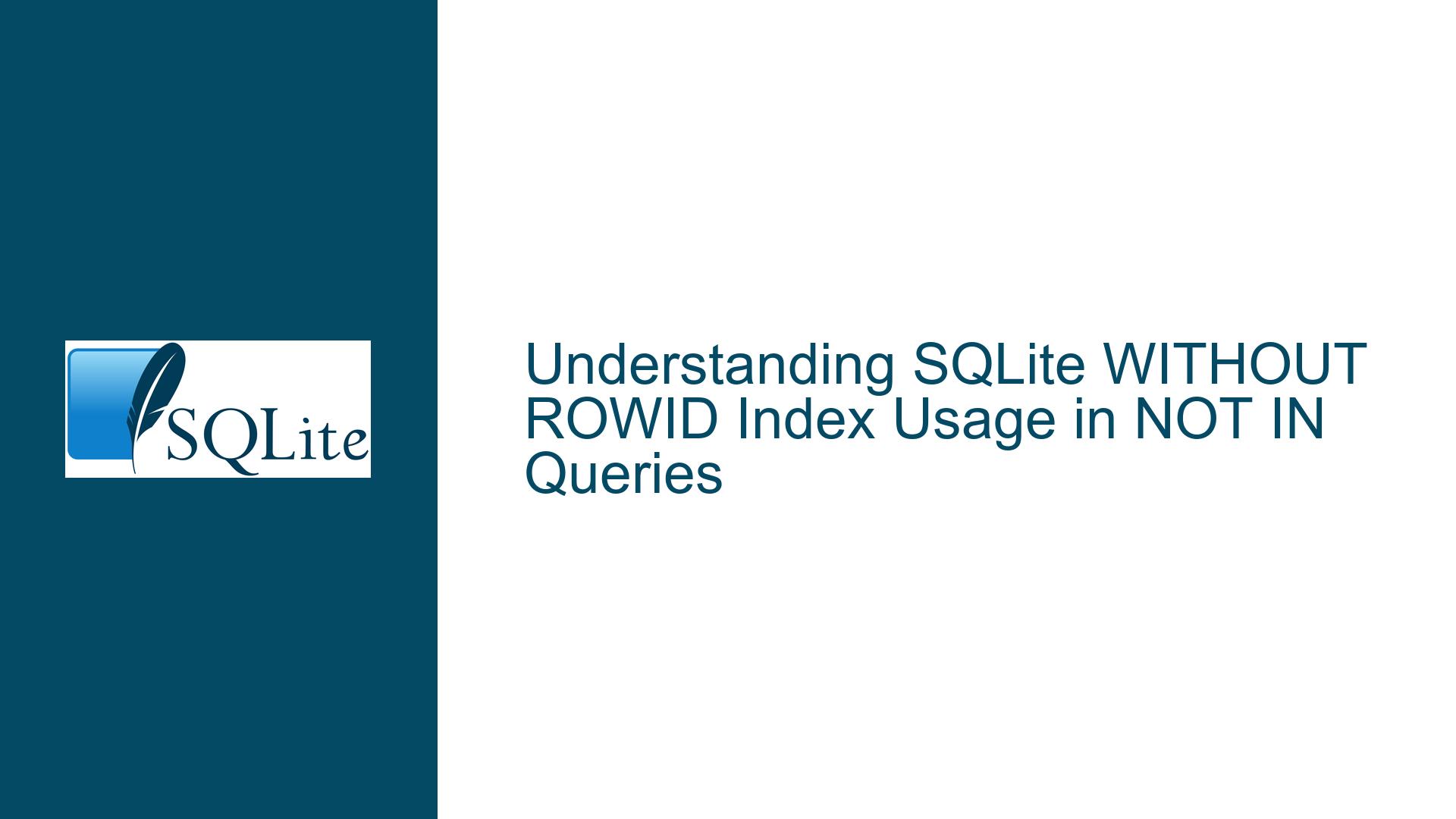SQLite WITHOUT ROWID Index Usage in NOT IN Queries
Issue Overview: SQLite WITHOUT ROWID Table and Index Usage in NOT IN Queries
The core issue revolves around the performance and query execution plan of a NOT IN subquery involving a WITHOUT ROWID table in SQLite. The user has two tables: content_index and lookups. The content_index table is defined as a WITHOUT ROWID table with a primary key on content_hash, while the lookups table has an auto-incrementing primary key and a content_hash column. The query in question attempts to find content_hash values in content_index that do not exist in lookups. The query execution plan shows a full table scan on content_index and a subquery scan on lookups, which is unexpectedly slow. The user is puzzled as to why the primary key index on content_index is not being utilized, especially since removing the WITHOUT ROWID clause results in the index being used.
The issue is further complicated by the size of the datasets: content_index contains approximately 6 million records, while lookups contains around 18 million records. The user expected the query to leverage the primary key index on content_index to efficiently filter out the content_hash values that exist in lookups. However, the query execution plan indicates that SQLite is performing a full table scan on content_index, which is causing the query to take an excessively long time to execute.
Possible Causes: Why the Index is Not Used in WITHOUT ROWID Tables for NOT IN Queries
The primary cause of the issue lies in the nature of the NOT IN operator and how SQLite optimizes queries involving WITHOUT ROWID tables. When a table is defined as WITHOUT ROWID, SQLite stores the table’s data in a B-tree structure where the primary key is used as the key for the B-tree. This design can lead to different query optimization behaviors compared to traditional rowid-based tables.
One key factor is that the NOT IN operator requires SQLite to determine which rows do not exist in the subquery result set. This is inherently more complex than finding rows that do exist, as it involves checking the absence of a value rather than its presence. In a traditional rowid-based table, SQLite might use an index to quickly locate rows that match a condition, but for NOT IN, the database engine often resorts to a full table scan to ensure that no matching rows are present.
Another factor is the size of the datasets involved. With 6 million records in content_index and 18 million records in lookups, the query engine faces a significant challenge in efficiently processing the NOT IN condition. The large dataset size exacerbates the performance impact of a full table scan, especially when the primary key index is not being utilized.
Additionally, the query execution plan suggests that SQLite is using a bloom filter to optimize the subquery. A bloom filter is a probabilistic data structure that can quickly tell if an element is not in a set, which can help reduce the number of comparisons needed. However, in this case, the bloom filter does not seem to be providing the expected performance improvement, possibly due to the large size of the lookups table.
The user also experimented with an alternative query using the EXCEPT operator, which produced a different query execution plan. However, the results of the EXCEPT query were not equivalent to the original NOT IN query, indicating that the two approaches are not interchangeable in this context.
Troubleshooting Steps, Solutions & Fixes: Optimizing NOT IN Queries with WITHOUT ROWID Tables
To address the performance issues with the NOT IN query involving a WITHOUT ROWID table, several strategies can be employed. These include modifying the query structure, leveraging additional indexes, and considering alternative database designs.
1. Query Structure Optimization:
Use EXISTS Instead of NOT IN: One common optimization technique is to replace the
NOT INoperator with aNOT EXISTSclause. TheNOT EXISTSoperator can often be more efficiently optimized by SQLite, as it allows the query engine to stop searching as soon as it finds a matching row. The modified query would look like this:SELECT content_hash FROM content_index WHERE NOT EXISTS ( SELECT 1 FROM lookups WHERE lookups.content_hash = content_index.content_hash );This approach can potentially reduce the number of comparisons needed, especially if the
lookupstable has an index oncontent_hash.Use LEFT JOIN with NULL Check: Another alternative is to use a
LEFT JOINand check forNULLvalues in the joined table. This approach can also be more efficient thanNOT INin some cases:SELECT ci.content_hash FROM content_index ci LEFT JOIN lookups l ON ci.content_hash = l.content_hash WHERE l.content_hash IS NULL;This query joins the
content_indextable with thelookupstable and filters out rows where no matchingcontent_hashis found inlookups.
2. Index Optimization:
Add an Index on
lookups.content_hash: While thecontent_indextable has a primary key index oncontent_hash, thelookupstable does not have an index on this column. Adding an index onlookups.content_hashcan significantly improve the performance of the subquery:CREATE INDEX idx_lookups_content_hash ON lookups(content_hash);This index allows SQLite to quickly locate rows in
lookupsthat match thecontent_hashvalues fromcontent_index, reducing the need for a full table scan.Consider Composite Indexes: If the query involves additional columns or conditions, a composite index might be beneficial. For example, if the query also filters on
type_idorarchive_id, a composite index on(content_hash, type_id, archive_id)could improve performance.
3. Database Design Considerations:
Reevaluate the Use of WITHOUT ROWID: While
WITHOUT ROWIDtables can offer performance benefits in certain scenarios, they may not always be the best choice for queries involvingNOT INor other complex conditions. If the primary key index is not being utilized as expected, it may be worth reconsidering the use ofWITHOUT ROWIDand testing the performance with a traditional rowid-based table.Partitioning Large Tables: Given the large size of the
content_indexandlookupstables, partitioning the data might help improve query performance. For example, the tables could be partitioned bycontent_hashranges or other criteria to reduce the amount of data that needs to be scanned for each query.
4. Analyzing Query Execution Plans:
Use EXPLAIN QUERY PLAN: To better understand how SQLite is executing the query, the
EXPLAIN QUERY PLANstatement can be used to generate a detailed query execution plan. This can help identify any inefficiencies or unexpected behaviors in the query execution:EXPLAIN QUERY PLAN SELECT content_hash FROM content_index WHERE content_hash NOT IN (SELECT content_hash FROM lookups);Analyzing the output of this command can provide insights into why the primary key index is not being used and whether any additional optimizations are needed.
Monitor Query Performance: Using SQLite’s built-in performance monitoring tools, such as the
sqlite3_profilefunction, can help track the execution time and resource usage of the query. This information can be used to identify bottlenecks and measure the impact of any optimizations.
5. Alternative Approaches:
Materialized Views: If the
NOT INquery is frequently executed and the data does not change often, creating a materialized view that precomputes the result set might be a viable solution. This approach can significantly reduce the query execution time by avoiding the need to recompute the result set each time the query is run.Batch Processing: For very large datasets, processing the query in smaller batches might be more efficient. This can be achieved by adding a
LIMITclause to the query and iterating through the results in chunks. While this approach requires more complex application logic, it can help manage resource usage and improve overall performance.
6. Testing and Validation:
Benchmark Different Approaches: After implementing any optimizations, it is important to benchmark the query performance to ensure that the changes have the desired effect. This can be done by running the query with different datasets and measuring the execution time and resource usage.
Validate Query Results: When modifying the query structure or adding indexes, it is crucial to validate that the query results remain accurate. This can be done by comparing the results of the optimized query with the original query to ensure consistency.
By carefully analyzing the query execution plan, optimizing the query structure, and considering alternative database designs, it is possible to significantly improve the performance of NOT IN queries involving WITHOUT ROWID tables in SQLite. While the WITHOUT ROWID feature offers certain advantages, it is important to understand its limitations and how it interacts with different query types to achieve optimal performance.






